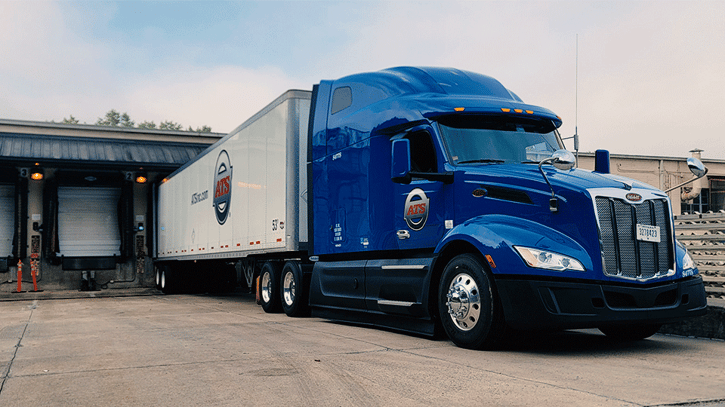
- Enclosed trailer capacity in July
- Open-deck capacity in July
- Major events affecting capacity this month
July is a hot month in the trucking industry, and we're not talking about weather. (At least, not just weather - it gets hot in those cabs, people!)
As Q3 kicks off in July, we see the southern states' produce season continues to ramp up, household goods move nationwide, and the Independence Day holiday put a dent in truck capacity.
Anderson Trucking Service, Inc. (ATS) has been around for a lot of Julys. As a result, we’ve refined our understanding of the trucking industry during this month and we’re here to explain what you should expect.
The busy summer months can be hard on shippers who don’t plan well, so in this article, we’ll tell you everything you need to know about locating trucking capacity this July.
Hold on to your floppy-brimmed hats and break out your sunscreen, friends. Let's get into it!
Dry Van and Reefer Capacity in July
During July, produce harvest in the southern U.S. and a nationwide surge in the movement of household goods make enclosed trailer capacity a bit harder to find.
Truck drivers go where the demand for their services is highest, so if you’re moving freight into the South this July, you’ll likely have no shortage of trucks at your disposal – and you may even get a break on your rate.

But moving your outbound freight from these areas may be more difficult. If drivers can maximize their time by moving loads within geographic areas that have plenty of freight – excuse the pun – ripe for the picking, it will take a higher rate to draw their services elsewhere.
As a result, expect to pay a bit more to secure dry van or reefer capacities out of the southern U.S. in July.
The increased movement of household goods in July affects capacity nationwide, so its effects are less concentrated than that of produce season.
As families pick up and move house, enclosed trailers are often dropped for several days while loading and unloading occurs, tying up that capacity in the process.
In turn, it may be more difficult (and more expensive) to find a dry van this month.
Open-Deck Capacity in July
The summer months are a flurry of activity for drivers hauling open-deck trailers, and July is no exception.
In the north, farm and construction machinery transported on specialized flatbed trailers are in constant motion right now. Harvest season is coming fast, and July is the perfect time to prepare.
In the South, an influx of over-dimensional and open-deck freight means increased competition for capacity – and increased rates to boot.
As a result, expect open deck capacity in these regions to cost a bit more than usual this month.

Major Events Affecting Capacity in July
In addition to the normal hustle and bustle of summer freight, there are a few major events that happen in July that may disrupt your ability to find a truck with ease.
Canada Day, Independence Day, and the Department of Transportation’s (DOT) Operation Safe Driver Week all influence the way freight moves around the U.S. in July.
Canada Day — July 1, 2025
On July 1, our Canadian neighbors celebrate their independence and unification with the Canada Day Holiday. Many workers will have or take the day off, including drivers and border enforcement employees.
As such, if you're looking to get goods across the U.S.-Canada border the week of July 1, expect to have more difficulty doing so. Be sure to plan well in advance for any shipments to and from Canada during this period, as truck capacity — especially on the Canadian side — will come at a premium.
Independence Day — July 4, 2025
Just a few days later, Americans celebrate our own Independence Day on July 4. Understandably, truckers don’t often want to be on the road during the 4th of July holiday, especially when they could be enjoying some well-deserved time off.
The lack of on-duty truckers can make finding capacity in the days leading up to and following Independence Day more difficult — especially if the holiday falls on a weekday, as it does in 2025 (Fri., July 4).
To combat this, you’ll want to lengthen your pick-up and delivery windows wherever possible. This will give drivers added flexibility with their scheduling and help you avoid the cost of finding a trucker who can meet a strict appointment on or around the holiday.
There are also many state-level restrictions on the transportation of over-dimensional cargo during this holiday period.
These restrictions vary from state to state. If you're in the business of moving OD freight during this period, make sure to consult your provider on how travel restrictions over the 4th of July will impact your freight.

DOT Operation Safe Driver Week — July 13-19, 2025
Finally, the annual DOT Operation Safe Driver Week will take place from July 13-19, 2025.
This joint effort between the DOT and the Commercial Motor Vehicle Safety Administration (CMVSA) aims to promote safe driving behaviors through a period of increased enforcement.
During this period, police will be out in full force checking drivers (both commercial and individual) for seatbelt usage and speed adherence.
Additionally, commercial drivers will be checked for electronic logging device (ELD) accuracy if they are pulled over during this time.
Increased governmental ELD oversight will make truckers hyper-vigilant about properly adhering to hours of service (HOS) regulations and maintaining their clocks.
As such, truckers operating during this time will be especially wary of anything that could throw off their schedule.
As a shipper, you can set yourself up for success over Operation Safe Driver Week by focusing on three things:
- Giving your transportation provider ample lead time
- Being realistic about loading/unloading efficiency
- Being flexible with your schedule whenever possible.
These behaviors will help your carrier properly plan the movement of trucks and drivers, which in turn will help drivers stay on top of their HOS clocks.
Best practices like these also make your freight more attractive to carriers and drivers all year round – not just in the month of July.
Stay Ahead of July's Freight Challenges
July brings more than just high temperatures — it brings real challenges for freight shippers trying to secure capacity in a competitive landscape.
From heightened demand for dry vans and reefers during produce and household moving seasons to elevated open-deck competition and capacity constraints around key holidays, this month demands thoughtful planning and strategic flexibility.
Understanding these seasonal pressures (and how major events like Independence Day, Canada Day, and Operation Safe Driver Week compound them) can help you make informed decisions, avoid unnecessary costs, and keep your supply chain running smoothly.
The more you know about how July shapes trucking trends, the more confident and successful you’ll be in navigating them.
Want even more practical insights? Check out our article on How Long Weekends Impact Freight Shipping. It’s filled with tips to help you plan for more successful shipments around holidays like the Fourth of July and beyond.



